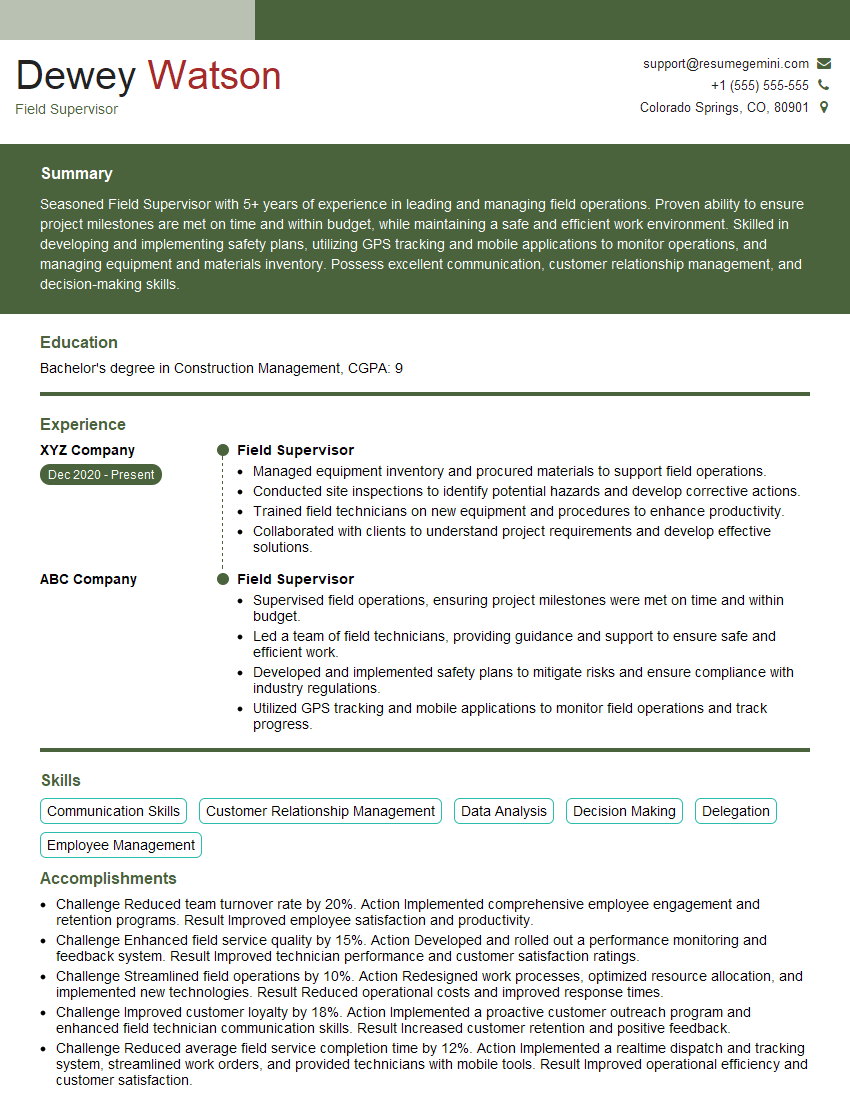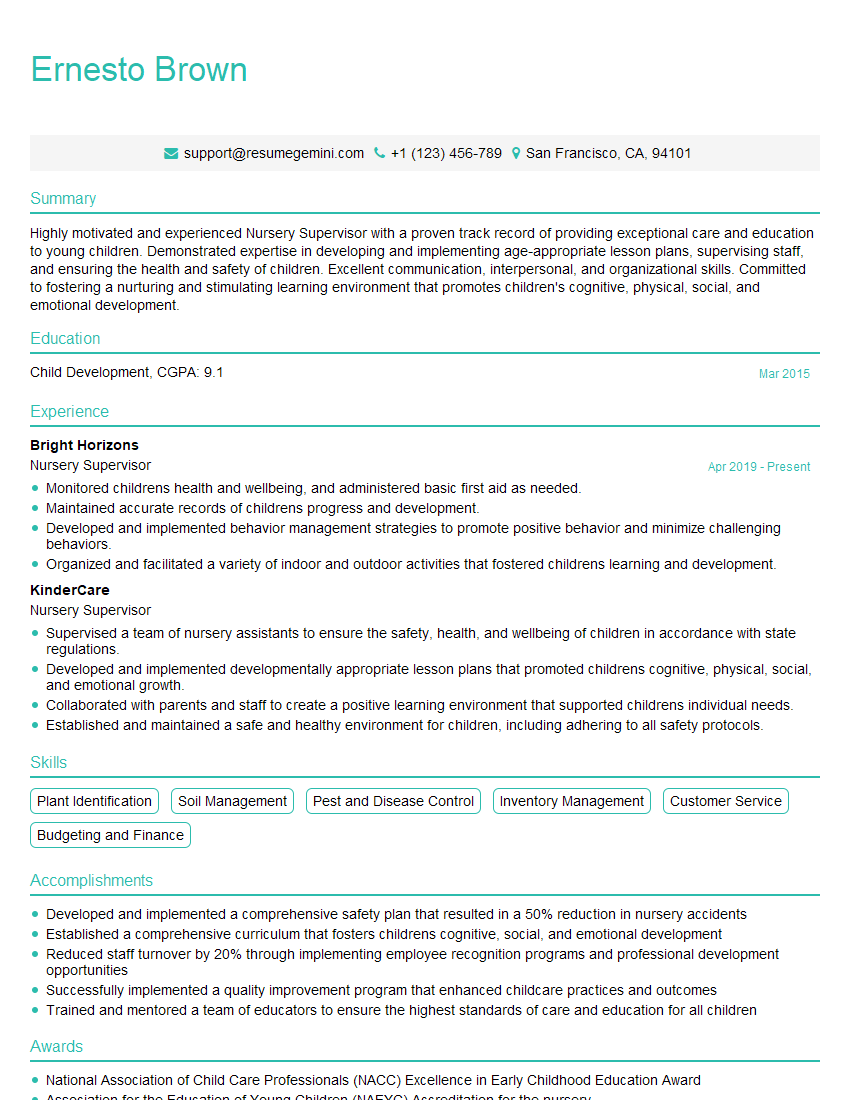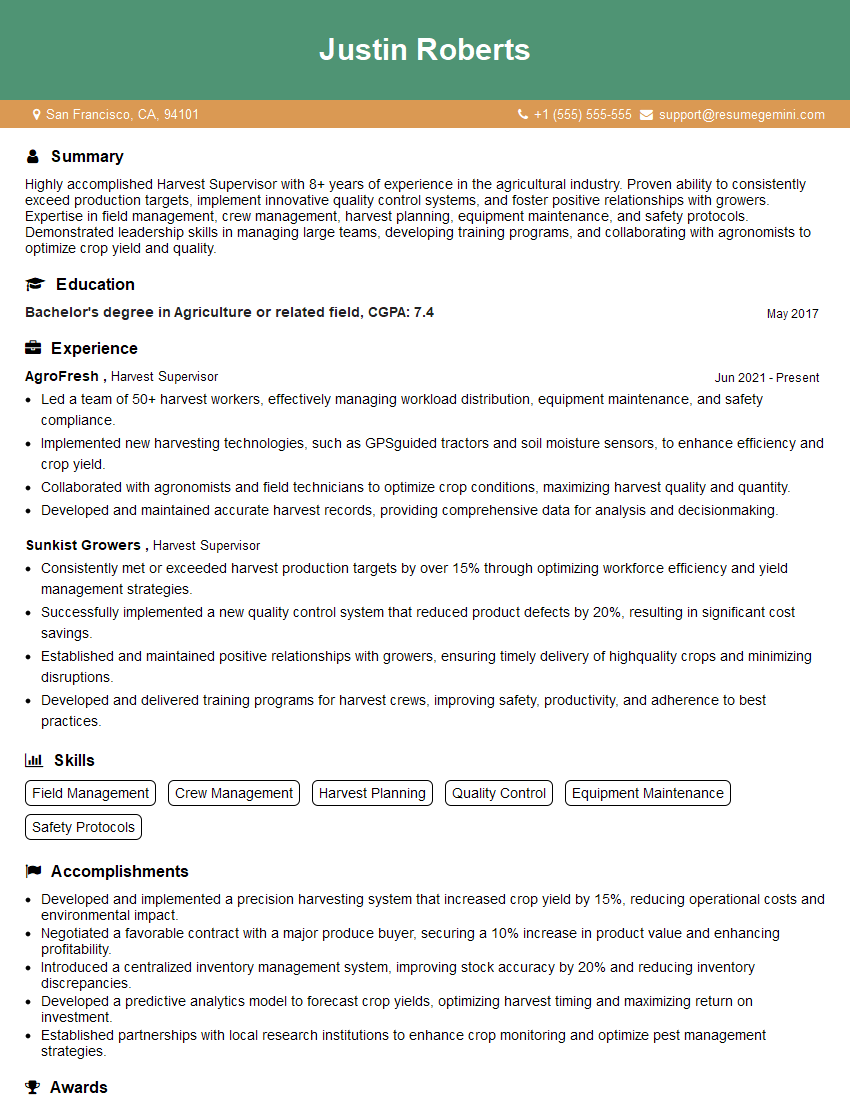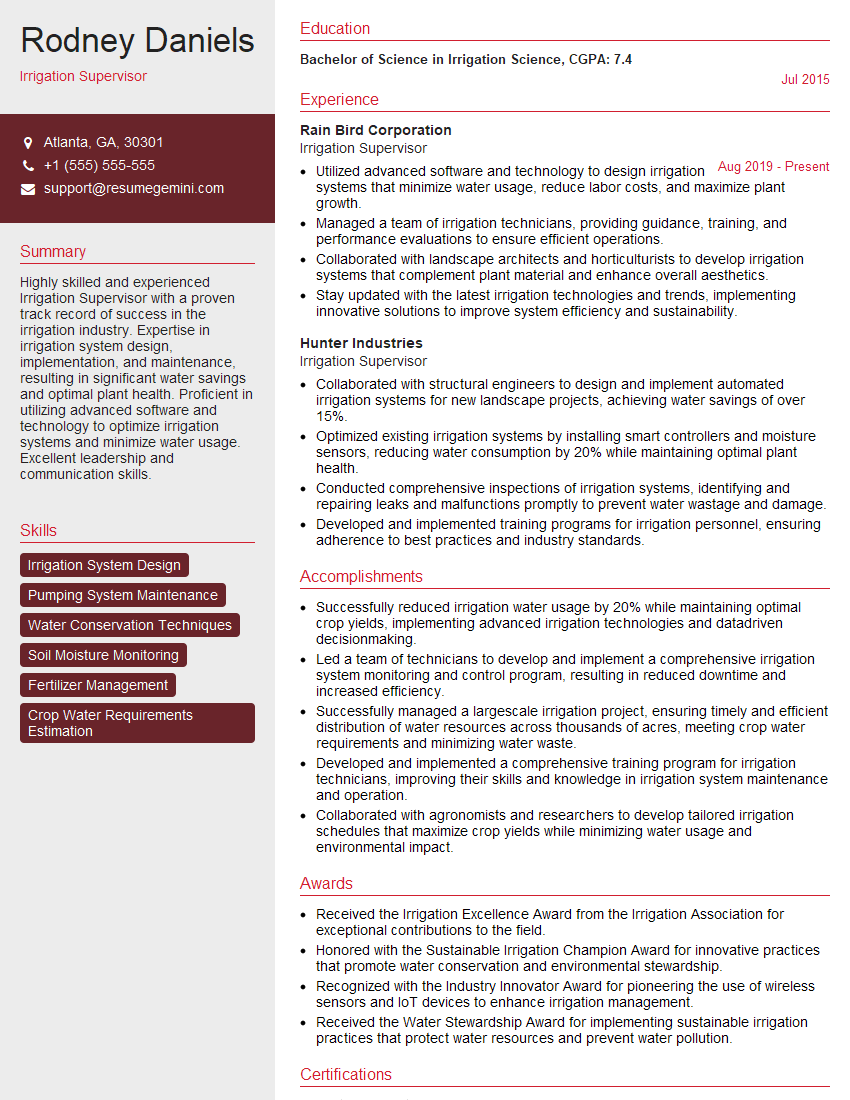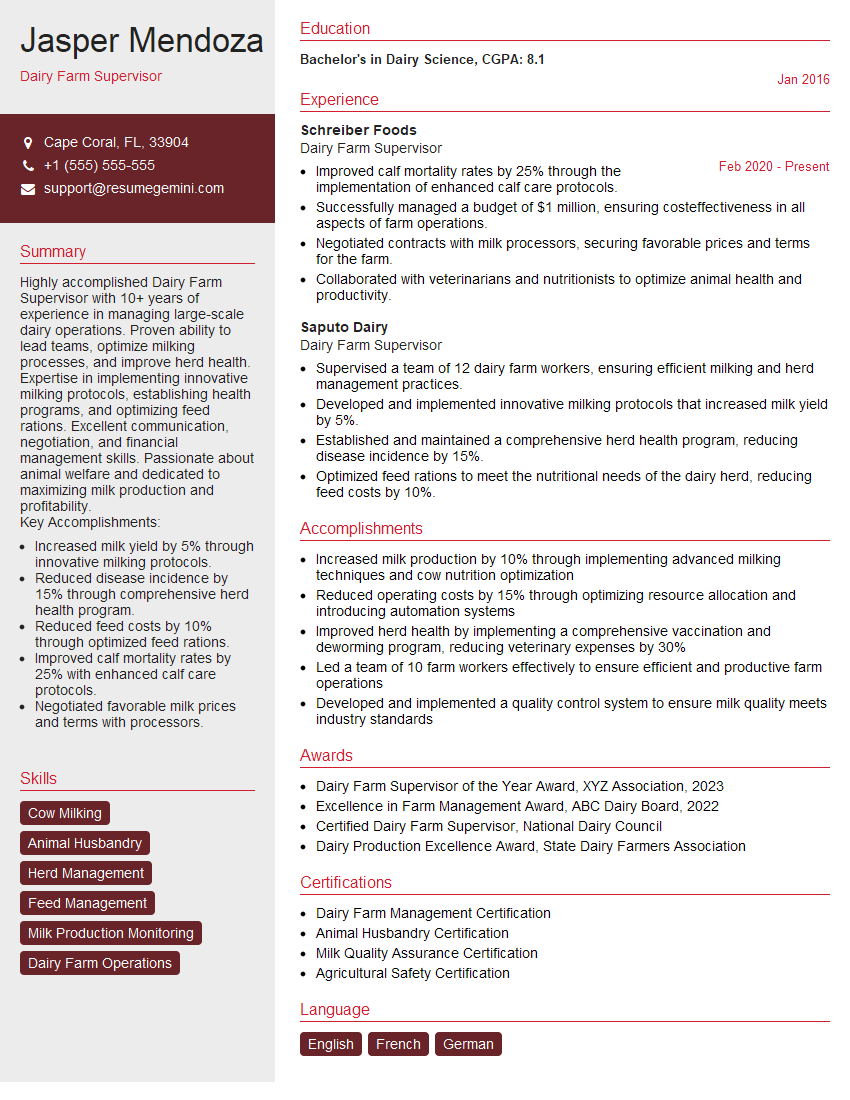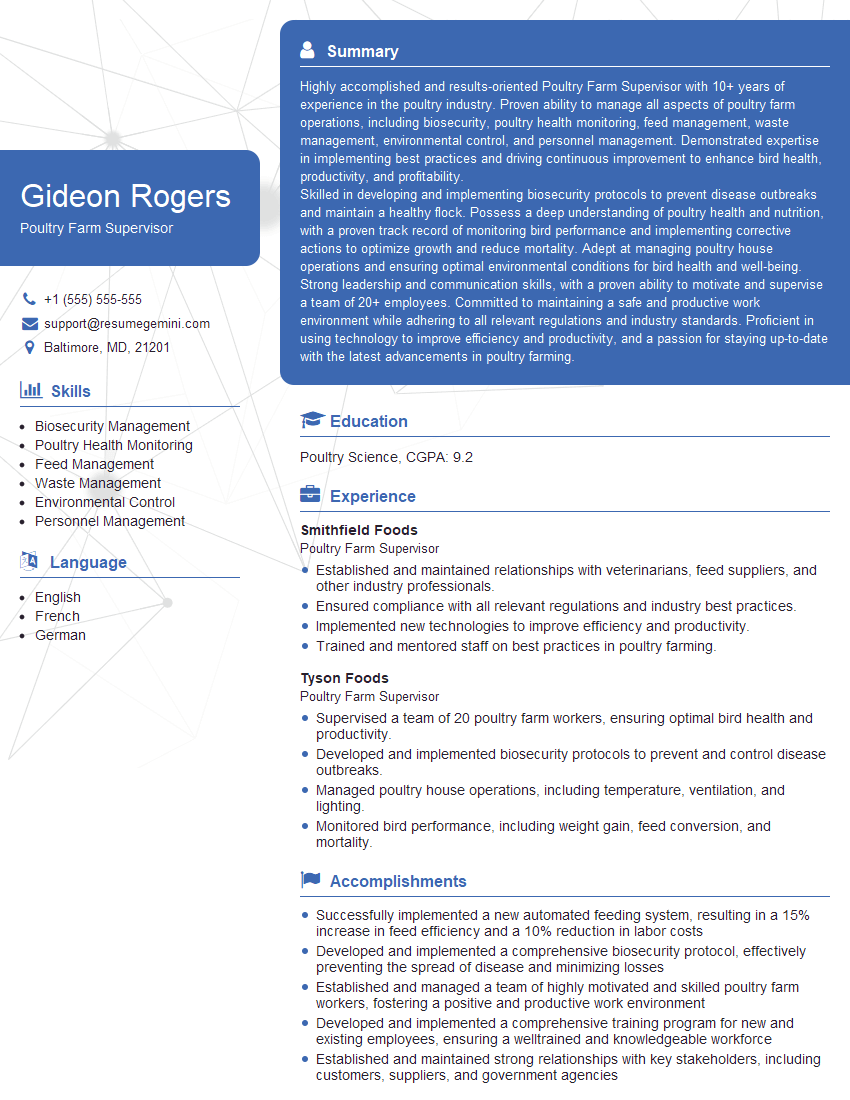Every successful interview starts with knowing what to expect. In this blog, we’ll take you through the top Farm Labor Supervision interview questions, breaking them down with expert tips to help you deliver impactful answers. Step into your next interview fully prepared and ready to succeed.
Questions Asked in Farm Labor Supervision Interview
Q 1. Describe your experience managing a farm labor crew of at least 10 workers.
Managing a farm labor crew of 10+ workers requires a blend of organizational skills, leadership, and interpersonal abilities. My experience involved overseeing a team of 12 harvesters on a large-scale apple orchard. This entailed daily task assignments, ensuring adequate equipment was available, and monitoring progress throughout the harvest season.
For example, I utilized a daily workflow system where tasks were broken down by individual skillsets and experience. Experienced workers handled the more challenging aspects of harvesting while newer workers received mentoring and close supervision on simpler tasks. This created a collaborative atmosphere while simultaneously optimizing efficiency. I regularly rotated tasks to prevent monotony and to help cross-train individuals, increasing the crew’s versatility. Regular communication—morning briefings and end-of-day debriefs—were key to keeping everyone informed and on track.
Q 2. How do you ensure compliance with all relevant labor laws and regulations?
Ensuring compliance with labor laws is paramount. My approach involves a multi-pronged strategy. Firstly, I maintain a thorough understanding of all relevant federal, state, and local regulations pertaining to farm labor, including wage and hour laws (Fair Labor Standards Act), worker safety regulations (OSHA), and immigration compliance.
Secondly, I ensure all workers receive a clear and easily understandable explanation of their rights and responsibilities. This often involves providing translated versions of important documents. Thirdly, I meticulously maintain accurate payroll records, ensuring proper documentation of hours worked, wages paid, and deductions. This involves using time tracking software and regularly reviewing for accuracy. Finally, I proactively seek updated information on labor laws through workshops, webinars, and consultations with legal professionals to remain ahead of any changes.
Q 3. Explain your approach to scheduling and assigning tasks to farm laborers.
Scheduling and task assignment hinge on several factors: the current harvest or planting schedule, the weather conditions, the crew’s skill levels, and the available equipment. I typically develop a weekly schedule, outlining tasks for each day, considering the optimal timing for specific activities (e.g., harvesting is best done in the cooler parts of the day).
Task assignments are tailored to individual abilities. I employ a combination of techniques: a predetermined rota for repetitive tasks to promote fairness, delegating more complex tasks to experienced individuals, and providing clear instructions and demonstrations to ensure understanding. Flexibility is key; unexpected events (like equipment malfunctions or weather changes) necessitate adjusting the schedule and responsibilities to maintain productivity. I find that open communication and providing clear rationale for my decisions helps the crew to understand and accept adjustments.
Q 4. What methods do you use to monitor worker productivity and efficiency?
Monitoring worker productivity and efficiency requires a balanced approach that avoids micromanagement while ensuring accountability. I use a combination of methods to track performance. This includes:
- Direct Observation: Regularly walking through the fields to visually assess progress and address any issues.
- Quantitative Measures: Tracking the quantity of work completed (e.g., bushels harvested, rows planted) per worker or per team.
- Performance Feedback: Providing regular feedback on performance, both positive reinforcement and constructive criticism, promoting continuous improvement.
- Data Analysis: Analyzing productivity data to identify trends, bottlenecks, and areas for improvement in both individual and team performance.
It’s crucial to celebrate successes and address shortcomings constructively, fostering a positive and productive work environment. Focusing on quality alongside quantity ensures the overall output meets the required standards.
Q 5. How do you handle conflicts or disagreements among farm laborers?
Conflict resolution is a crucial aspect of farm labor supervision. My approach is centered on prompt and fair intervention. When disagreements arise, I encourage open communication and active listening to understand each perspective.
I act as a neutral mediator, facilitating a discussion where workers can express their concerns without interruption. I encourage them to find a mutually agreeable solution. If a solution cannot be reached, I may need to intervene more directly, outlining expectations and consequences of continued conflict. Documentation of the incident and the resolution is important. In more serious cases, involving HR or management may be necessary. The goal is always to resolve conflicts swiftly and fairly to maintain a harmonious and productive work environment.
Q 6. Describe your experience with training and supervising new farm laborers.
Training and supervising new farm laborers is an ongoing process. I start by providing a comprehensive orientation, covering safety procedures, farm policies, and task-specific instructions. I use a combination of techniques:
- On-the-job training: Pairing new workers with experienced colleagues for hands-on guidance.
- Demonstrations and visual aids: Showcasing proper techniques and using diagrams or videos to reinforce instruction.
- Regular check-ins and feedback: Monitoring progress and providing constructive criticism.
- Mentorship programs: Assigning experienced workers to mentor new hires, fostering a sense of community and support.
Emphasis is placed on safety training, demonstrating the correct use of equipment and highlighting potential hazards. Continuous assessment ensures understanding and allows adjustments to the training methods as needed.
Q 7. What safety measures do you implement to ensure a safe working environment?
Safety is a top priority. My approach involves a layered safety program:
- Pre-employment screening: Ensuring workers are physically capable of handling the tasks.
- Safety training: Providing comprehensive training on safe work practices, equipment use, and hazard identification.
- Personal Protective Equipment (PPE): Ensuring workers have access to and use appropriate PPE (gloves, eye protection, safety footwear).
- Regular safety inspections: Identifying and addressing potential hazards in the work environment.
- Emergency response plan: Establishing clear procedures for handling emergencies and injuries.
- Communication and reporting mechanisms: Creating open communication channels for workers to report safety concerns without fear of reprisal.
Regular safety meetings and refresher training are essential to maintain awareness and prevent accidents. A safe work environment not only protects workers but also boosts morale and productivity.
Q 8. How do you manage worker attendance and timekeeping?
Effective farm labor attendance and timekeeping is crucial for productivity and payroll accuracy. I utilize a combination of methods, starting with a clear, easily understandable scheduling system. This usually involves a digital calendar or whiteboard, clearly displaying daily tasks and assigned personnel. Each worker receives a copy of the schedule, and any changes are communicated promptly.
For timekeeping, we use a combination of biometric time clocks and a dedicated time-tracking software application. This allows for precise recording of hours worked, including start and end times, breaks, and any overtime. The software automatically calculates wages based on hourly rates and overtime rules. We also maintain a paper trail of handwritten time sheets as a backup. Regularly reviewing this data helps identify any discrepancies and ensures fair compensation. This dual-system approach minimizes errors and provides redundancy in case of technical difficulties.
Finally, I perform regular audits to compare the recorded hours against actual work completed and planned output, which helps identify potential issues with scheduling, worker performance, or even equipment malfunctions that might be impacting productivity.
Q 9. How do you motivate and retain farm laborers?
Motivating and retaining farm laborers requires a multifaceted approach that goes beyond fair wages. I prioritize creating a positive and supportive work environment. This includes open communication, where workers feel comfortable voicing concerns and suggestions. I regularly hold team meetings to discuss progress, challenges, and future plans, ensuring everyone feels valued and heard.
Beyond communication, providing opportunities for skill development is vital. This can range from on-the-job training to sponsoring relevant courses or workshops. Offering opportunities for advancement within the farm also fosters loyalty and encourages long-term commitment. For instance, a dedicated and skilled worker might be promoted to a crew leader or trainer, adding responsibility and increasing their compensation.
Finally, I believe in recognizing and rewarding hard work and dedication. This could include bonuses for exceeding targets, offering flexible scheduling options where possible, or simply acknowledging individual achievements in team meetings. A respectful and appreciative atmosphere greatly enhances morale and reduces employee turnover.
Q 10. What strategies do you use to improve farm labor efficiency?
Improving farm labor efficiency involves a systematic approach that focuses on both people and processes. One key strategy is efficient task allocation. I analyze the tasks required for each day, taking into account worker skills and experience to assign tasks accordingly. This ensures that individuals are working to their strengths and minimizes wasted time and resources.
Another important aspect is optimizing workflow. This involves minimizing unnecessary movements and streamlining processes. For example, I might rearrange the layout of the farm to reduce travel time between different work areas. Additionally, I utilize and train workers on the use of technology, such as GPS-guided machinery and harvest monitoring tools, for greater precision and productivity.
Regular performance monitoring and feedback are also crucial. By tracking productivity levels and identifying bottlenecks, we can pinpoint areas needing improvement. Regular feedback sessions with workers allow for open discussion and problem-solving, ensuring continuous improvement in efficiency. Training and cross-training workers increases flexibility and reduces reliance on individual workers, improving overall resilience.
Q 11. Describe your experience with farm equipment operation and maintenance.
My experience with farm equipment encompasses a wide range of machinery, including tractors, harvesters, irrigation systems, and various smaller tools. I am proficient in their operation, maintenance, and troubleshooting. I’m also familiar with safety regulations and procedures pertaining to their use.
Over the years, I’ve developed strong mechanical aptitude and regularly perform preventative maintenance tasks such as oil changes, filter replacements, and lubrication to extend equipment lifespan and minimize breakdowns. I’m also adept at diagnosing minor issues, performing basic repairs, and scheduling more complex repairs with qualified mechanics when necessary. I maintain detailed records of maintenance schedules and repair history for all equipment.
My expertise extends to training and supervising workers on safe and efficient equipment operation, reinforcing the importance of regular checks and proper handling procedures to minimize accidents and maximize equipment life. I always emphasize the importance of safety training before any worker operates equipment.
Q 12. How do you handle unexpected equipment breakdowns or delays?
Unexpected equipment breakdowns or delays are inevitable in farming. My approach focuses on preparedness and swift response. First, I have a well-established maintenance schedule to minimize unexpected issues. Second, I maintain a network of reliable repair technicians and readily available parts to minimize downtime.
When a breakdown occurs, I follow a structured protocol. I first assess the situation, determining the severity of the problem and its impact on the ongoing operations. I then communicate the situation to relevant personnel, including other crew members, management, and the repair team. In the meantime, I might reassign workers to alternative tasks to mitigate the impact on overall productivity, if possible.
Once the repair is completed, I thoroughly document the incident, including the cause of the breakdown, repair time, and associated costs. This information helps in identifying recurring issues and implementing preventative measures to reduce the likelihood of similar future events.
Q 13. How do you manage farm labor costs effectively?
Managing farm labor costs effectively requires a balance between fair compensation and efficient resource allocation. Careful budgeting and accurate forecasting are essential. I start by creating a detailed budget that accounts for all labor-related expenses, including wages, benefits, training, and other relevant costs.
Efficient scheduling and task allocation play a crucial role. By optimizing workflow and minimizing idle time, we can maximize output while keeping labor costs in check. Regular monitoring of labor costs against the budget helps identify any potential overruns early on, allowing for timely corrective action.
Negotiating favorable contracts with labor suppliers, exploring worker incentives tied to productivity and exploring technology to automate some tasks can further help reduce costs without compromising worker satisfaction. Regular analysis of productivity data helps identify areas where efficiency improvements can reduce overall labor costs. This multi-faceted strategy ensures sustainable cost management without compromising the well-being or productivity of the workforce.
Q 14. What are your methods for tracking harvest yields and quality?
Tracking harvest yields and quality is critical for assessing farm performance and making data-driven decisions. I use a combination of methods for this purpose, starting with meticulous record-keeping. We record the quantity and quality of harvested produce at each stage of the process, including field location, date, and time of harvest. This information is typically recorded manually in the field and then entered into a centralized database.
We use calibrated weighing scales and standardized grading procedures to ensure accuracy and consistency in measuring yields and quality parameters such as size, weight, and appearance. Technology plays a crucial role here; we use handheld devices or software integrated with harvesters to automatically record this data. This greatly reduces the chance of human error and speeds up the data entry process.
Regular analysis of this data provides valuable insights into farm productivity, identifies areas for improvement in cultivation practices or harvesting techniques, and allows for more precise forecasting and inventory management. This data also helps us comply with regulatory requirements for production records and allows us to demonstrate quality assurance to buyers.
Q 15. How do you ensure the proper use and storage of pesticides and fertilizers?
Ensuring the proper use and storage of pesticides and fertilizers is paramount for worker safety and environmental protection. It involves a multi-pronged approach encompassing training, strict adherence to regulations, and meticulous record-keeping.
- Training: All farm laborers receive comprehensive training on the safe handling, application, and disposal of pesticides and fertilizers. This includes identifying hazard symbols, understanding personal protective equipment (PPE) requirements (gloves, masks, eye protection), and following label instructions precisely. We use both classroom instruction and hands-on demonstrations to reinforce learning. For example, we’ll conduct practical sessions showing the correct way to mix and apply chemicals, emphasizing the importance of calibrated application to avoid overuse and environmental runoff.
- Storage: Pesticides and fertilizers are stored in designated, locked areas, away from food, water sources, and livestock. Storage areas are well-ventilated and protected from extreme temperatures and weather. We maintain a detailed inventory, including acquisition dates and expiry dates, to prevent the use of outdated materials. This helps ensure that only approved, effective, and safe products are used.
- Record-Keeping: Detailed records are maintained for every pesticide and fertilizer application, including the product name, application date, area treated, amount used, and the individuals involved. This data is crucial for compliance audits and for tracking the effectiveness of different treatments. We use a combination of physical logbooks and digital software to ensure efficient record-keeping and easy access to information.
For instance, in one instance, we noticed a slight increase in pest activity despite regular applications. By reviewing our detailed records, we were able to identify that a particular batch of pesticide may have been compromised and promptly corrected the issue, preventing a more significant infestation.
Career Expert Tips:
- Ace those interviews! Prepare effectively by reviewing the Top 50 Most Common Interview Questions on ResumeGemini.
- Navigate your job search with confidence! Explore a wide range of Career Tips on ResumeGemini. Learn about common challenges and recommendations to overcome them.
- Craft the perfect resume! Master the Art of Resume Writing with ResumeGemini’s guide. Showcase your unique qualifications and achievements effectively.
- Don’t miss out on holiday savings! Build your dream resume with ResumeGemini’s ATS optimized templates.
Q 16. How do you communicate effectively with farm laborers who may not speak English?
Effective communication with farm laborers who may not speak English is crucial for safety, productivity, and a positive work environment. I utilize a multi-faceted strategy:
- Bilingual Supervisors/Interpreters: Employing supervisors or interpreters who are fluent in the laborers’ native language is the most effective method. This ensures clear understanding of instructions, safety protocols, and any work-related concerns. I have personally worked with several teams, including those with predominantly Spanish-speaking laborers, and having a fluent translator significantly reduces misunderstandings and improves efficiency.
- Visual Aids: Using diagrams, pictures, and videos to demonstrate tasks and safety procedures complements verbal communication. A picture of the correct way to use protective equipment is far more universally understood than written instructions.
- Translation Apps and Services: While not a replacement for human interaction, translation apps can be helpful for simple communication or clarifying specific points. For instance, I’ve used translation apps in urgent situations, such as conveying the need for immediate medical attention, effectively.
- Learn Basic Phrases: Even learning basic phrases in the workers’ language shows respect and builds trust. Making an effort to learn even a few simple greetings goes a long way.
For example, during a training session on pesticide application, we used a combination of visual aids showing proper equipment usage and a bilingual supervisor who explained the steps in detail in Spanish. This approach proved far more effective than relying on just English instructions.
Q 17. Describe your experience with budgeting and resource allocation for farm labor.
Budgeting and resource allocation for farm labor require careful planning and forecasting. My experience involves a three-step process:
- Needs Assessment: First, I assess the labor needs based on the crops being cultivated, the size of the farm, and anticipated workload throughout the growing season. This includes considering peak seasons that require more hands and periods of lower demand.
- Budget Development: Once the labor needs are determined, I develop a detailed budget incorporating wages, benefits, training costs, and potential overtime pay. This budget is then integrated into the farm’s overall operational budget. I also factor in potential fluctuations in labor costs, due to seasonal demand or market changes.
- Resource Allocation: Finally, I allocate resources effectively to meet the demands. This might involve hiring seasonal workers, investing in labor-saving machinery, or adjusting work schedules to optimize productivity while staying within the budget.
For instance, in one instance, I successfully negotiated a contract with a local labor agency that provided a flexible workforce, allowing me to scale our labor force up or down depending on the season. This minimized labor costs while ensuring we always had the right number of workers to complete tasks efficiently.
Q 18. How do you address employee performance issues?
Addressing employee performance issues requires a fair, consistent, and constructive approach. My process emphasizes:
- Observation and Documentation: I closely monitor employee performance and document any instances of concern. This documentation serves as a record of the issue and provides evidence in case of future disputes.
- Private Conversation: I address performance issues privately with the employee, offering specific examples of their performance and avoiding personal attacks. The goal is to understand the root cause of the problem, whether it’s lack of training, equipment malfunction, or personal circumstances.
- Coaching and Mentorship: Once the issue is understood, I provide coaching and mentorship to help the employee improve their skills and performance. This might include additional training, adjustments to work assignments, or pairing them with a more experienced worker.
- Disciplinary Action (If Necessary): If the problem persists despite attempts at coaching and mentorship, I resort to progressive disciplinary action. This follows a documented process with clear expectations and consequences. Always maintaining a transparent and fair approach is crucial.
In one case, an employee consistently missed daily targets. After a private conversation, it emerged that they were struggling with a family emergency. By providing some flexibility and support, we were able to address the underlying issue and improve their performance.
Q 19. What is your experience with different harvesting techniques?
My experience encompasses various harvesting techniques, adapting to the specific crop and available resources. This includes:
- Manual Harvesting: This is still relevant for certain high-value crops or those requiring delicate handling. I’m experienced in coordinating teams for effective manual harvesting, ensuring quality and safety standards are met. This often involves training laborers in proper picking techniques to avoid damage to the produce.
- Mechanical Harvesting: For larger-scale operations, mechanical harvesting is often more efficient. My experience includes overseeing the operation and maintenance of harvesting machinery, as well as ensuring worker safety around these machines.
- Automated Harvesting Systems: I’m familiar with newer technologies, such as automated harvesting robots. While less common in our operations, understanding their potential applications and limitations is crucial for future planning.
For example, during a grape harvest, we utilized a combination of manual and mechanical harvesting. Manually harvesting smaller, delicate bunches ensured quality, while mechanical harvesting handled the larger quantities. This balanced efficiency with produce quality.
Q 20. How do you adapt to changing weather conditions and their impact on farm labor?
Adapting to changing weather conditions and their impact on farm labor requires proactive planning and flexibility. My approach involves:
- Weather Monitoring: We closely monitor weather forecasts to anticipate potential problems, such as heat waves, storms, or frost. This enables us to plan for contingencies and adjust work schedules accordingly.
- Flexible Scheduling: When severe weather threatens, we adjust schedules to ensure worker safety. This might mean postponing work, working shorter hours, or relocating workers to sheltered areas.
- Heat Stress Prevention: During hot weather, we implement strategies to mitigate heat stress, such as providing adequate hydration breaks, shaded work areas, and encouraging the use of light clothing.
- Cold Weather Protection: In cold weather, we provide warm clothing and ensure adequate breaks in heated areas. We also monitor workers for signs of hypothermia.
For example, during a sudden heatwave, we shortened workdays, provided extra hydration breaks, and repositioned workers to areas with more shade, preventing any heat-related illnesses.
Q 21. What is your experience with record-keeping and reporting related to farm labor?
Record-keeping and reporting related to farm labor are essential for compliance, efficiency, and informed decision-making. My experience involves:
- Daily Time Sheets: Accurate daily time sheets are maintained for every worker, recording hours worked, tasks performed, and any overtime. This data is crucial for payroll processing and labor cost tracking.
- Payroll Records: Complete and accurate payroll records are maintained, ensuring compliance with all relevant labor laws and regulations. This includes documenting wages, deductions, and benefit payments.
- Worker Information: We maintain detailed records of each worker’s employment history, including contact information, emergency contacts, and any relevant certifications or training received.
- Injury and Accident Reports: Comprehensive injury and accident reports are prepared and submitted to the appropriate authorities. This information is critical for identifying safety hazards and implementing preventative measures.
- Compliance Reporting: We prepare reports required by regulatory bodies, ensuring compliance with labor laws and safety standards. This involves meticulous record-keeping and analysis of labor data.
I have consistently used a combination of physical and digital record-keeping to ensure both accessibility and data security. This approach has allowed for more efficient payroll processing and accurate reporting, contributing to better decision-making at the farm level.
Q 22. Describe your experience with implementing new technologies in farm labor management.
Implementing new technologies in farm labor management is crucial for increasing efficiency and productivity. My experience involves leveraging several technologies, including GPS-enabled machinery for precise planting and harvesting, which reduces labor needs and minimizes waste. We’ve also integrated farm management software to track worker hours, attendance, and performance, providing valuable data for better scheduling and resource allocation. For example, we transitioned from manual timekeeping to a biometric system, eliminating inaccuracies and reducing payroll processing time significantly. Further, using mobile apps for communication with workers regarding tasks and schedules ensures real-time updates and fosters better collaboration. This technology adoption requires careful training and support for workers to ensure seamless integration and avoid frustration. For instance, we conducted hands-on workshops with our team to teach them how to use the new software effectively.
Q 23. How do you ensure worker compliance with farm safety procedures?
Ensuring worker compliance with farm safety procedures is paramount. My approach involves a multi-pronged strategy. First, comprehensive safety training is provided to all employees upon hire and regularly reinforced through refresher courses and safety meetings. This training covers topics such as proper use of equipment, handling of hazardous materials, and emergency procedures. Second, clear and visible signage detailing safety regulations is placed throughout the farm. Third, we conduct regular safety inspections to identify and rectify potential hazards promptly. Finally, we implement a system of accountability where workers are responsible for reporting any safety concerns or incidents immediately. This system also includes rewarding employees who consistently adhere to safety protocols. For instance, we introduced a ‘Safety Star’ program where employees who demonstrate exceptional safety awareness receive recognition and small rewards. This positive reinforcement significantly boosts safety compliance.
Q 24. How do you handle employee absences or turnover?
Handling employee absences and turnover requires proactive planning and a strong team. For absences, we utilize a clear and easily accessible absence reporting system, often through a dedicated contact person. We also maintain a pool of reliable temporary workers who can step in during short-term absences. Regarding turnover, we focus on improving employee retention by offering competitive wages and benefits, creating a positive work environment, and providing opportunities for professional development. For example, we offer seasonal bonuses and implement employee feedback systems to address concerns and improve working conditions. We also identify and train promising workers to take on leadership roles, providing career advancement within the farm. Understanding the reasons for employee departures—through exit interviews—helps us identify areas for improvement in our management practices.
Q 25. What are your methods for evaluating the effectiveness of farm labor training programs?
Evaluating the effectiveness of farm labor training programs requires a multi-faceted approach. We measure program effectiveness through pre- and post-training assessments to gauge knowledge gain and skill development. We also track on-the-job performance, observing the application of learned skills and identifying areas where further training may be needed. Feedback surveys from participants provide valuable insights into their learning experience and suggestions for improvement. Finally, we analyze key performance indicators such as accident rates, waste reduction, and overall productivity to determine the impact of training on farm operations. For example, if pesticide handling training reduces accidental exposure incidents, we can quantitatively demonstrate the program’s success.
Q 26. Describe your experience with crop rotation and its impact on labor requirements.
Crop rotation significantly impacts labor requirements. Different crops have varying labor demands throughout their growing cycles. For instance, labor-intensive crops like strawberries require significant hand-harvesting, while less labor-intensive crops like corn require less manual intervention after initial planting. By strategically rotating crops, we can balance labor needs throughout the year, avoiding periods of excessive demand and minimizing the need for seasonal hiring surges. Careful planning of the rotation schedule, considering factors such as labor availability and market demand, is crucial for optimizing labor utilization and overall farm efficiency. This planning often involves forecasting labor needs based on historical data and projected yields for each crop in the rotation.
Q 27. How do you ensure compliance with environmental regulations related to farm labor practices?
Ensuring compliance with environmental regulations related to farm labor practices is a top priority. This involves adhering to regulations on pesticide application, waste disposal, and water management. We provide thorough training to workers on proper handling of pesticides and other hazardous materials, emphasizing safety precautions and legal requirements. We maintain detailed records of pesticide applications and waste disposal, ensuring accurate tracking for compliance audits. We also implement sustainable practices to minimize environmental impact, such as using integrated pest management strategies and minimizing water usage. Regular environmental impact assessments help us identify areas for improvement and maintain our compliance.
Q 28. What strategies do you use to minimize the risk of workplace accidents?
Minimizing workplace accidents requires a proactive and comprehensive approach. This starts with providing thorough safety training and equipping workers with appropriate personal protective equipment (PPE). Regular equipment maintenance and inspections are crucial in preventing mechanical failures. Clear communication channels encourage workers to report safety hazards promptly. We also implement a robust reporting system for all incidents, allowing us to identify trends and implement corrective actions. A strong safety culture, fostered through regular safety meetings and positive reinforcement, is fundamental. For example, our farm implements a ‘buddy system’ where workers look out for each other’s safety. This creates a sense of shared responsibility and promotes a safer work environment.
Key Topics to Learn for Farm Labor Supervision Interview
- Crew Management & Leadership: Understanding effective communication, delegation, and motivation techniques for farm labor crews. Practical application: Developing strategies to improve team productivity and morale while maintaining safety standards.
- Crop Knowledge & Harvesting Techniques: Demonstrating familiarity with various crops, their growth cycles, and optimal harvesting methods. Practical application: Troubleshooting issues in the field, adjusting harvesting schedules based on weather conditions and crop maturity.
- Safety Regulations & Compliance: Knowledge of OSHA regulations and farm-specific safety protocols. Practical application: Implementing and enforcing safety procedures to prevent accidents and injuries within the crew.
- Record Keeping & Reporting: Accurate tracking of labor hours, yields, and expenses. Practical application: Generating clear and concise reports for management, demonstrating efficiency and accountability.
- Budgeting & Resource Management: Effective allocation of resources, including labor, equipment, and materials. Practical application: Optimizing costs while maintaining productivity and quality.
- Problem-Solving & Conflict Resolution: Addressing challenges related to labor disputes, equipment malfunctions, and weather-related setbacks. Practical application: Developing solutions that minimize disruption and maintain operational efficiency.
- Training & Development: Providing effective training to farm laborers on safe work practices, efficient techniques, and new technologies. Practical application: Implementing a training program that enhances skills and improves overall team performance.
Next Steps
Mastering Farm Labor Supervision opens doors to leadership roles with increased responsibility and earning potential. A strong resume is crucial for showcasing your skills and experience to potential employers. Building an ATS-friendly resume significantly increases your chances of getting your application noticed. ResumeGemini is a trusted resource that can help you craft a compelling and effective resume. Examples of resumes tailored specifically to Farm Labor Supervision are available to guide you through the process.
Explore more articles
Users Rating of Our Blogs
Share Your Experience
We value your feedback! Please rate our content and share your thoughts (optional).
What Readers Say About Our Blog
Hello,
We found issues with your domain’s email setup that may be sending your messages to spam or blocking them completely. InboxShield Mini shows you how to fix it in minutes — no tech skills required.
Scan your domain now for details: https://inboxshield-mini.com/
— Adam @ InboxShield Mini
Reply STOP to unsubscribe
Hi, are you owner of interviewgemini.com? What if I told you I could help you find extra time in your schedule, reconnect with leads you didn’t even realize you missed, and bring in more “I want to work with you” conversations, without increasing your ad spend or hiring a full-time employee?
All with a flexible, budget-friendly service that could easily pay for itself. Sounds good?
Would it be nice to jump on a quick 10-minute call so I can show you exactly how we make this work?
Best,
Hapei
Marketing Director
Hey, I know you’re the owner of interviewgemini.com. I’ll be quick.
Fundraising for your business is tough and time-consuming. We make it easier by guaranteeing two private investor meetings each month, for six months. No demos, no pitch events – just direct introductions to active investors matched to your startup.
If youR17;re raising, this could help you build real momentum. Want me to send more info?
Hi, I represent an SEO company that specialises in getting you AI citations and higher rankings on Google. I’d like to offer you a 100% free SEO audit for your website. Would you be interested?
Hi, I represent an SEO company that specialises in getting you AI citations and higher rankings on Google. I’d like to offer you a 100% free SEO audit for your website. Would you be interested?
good
